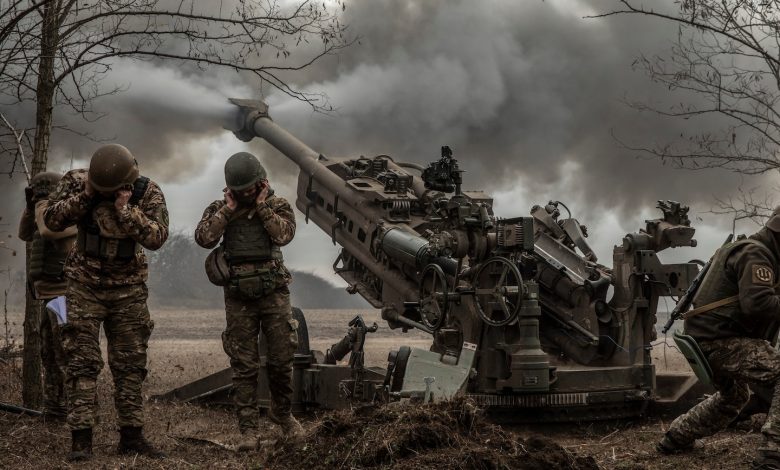U.S. unveils $1 billion Ukraine weapons package

The announcement coincided with a separate disclosure from the U.S. government acknowledging that last month the Pentagon secretly shipped Ukraine’s military powerful long-range missiles, which were used in recent days to attack a Russian airfield on the Crimean Peninsula.
Taken together, the developments appeared to suggest that Washington, having overcome an acrimonious period of political paralysis, was ready to reinvigorate its expansive initiative to support and sustain Ukraine’s embattled military as the war with Russia moves into its third year.
Officials said that elements of the new weapons package, with an overall estimated value of $1 billion, would reach the battlefield within days. The Pentagon, having anticipated lawmakers would end their impasse, signaled in recent days it was working behind the scenes to prepare.
President Biden, in remarks Wednesday morning, said shipments would begin in the “next few hours,” and blamed a contingent of the GOP for causing what he characterized as a perilous delay.
“While MAGA Republicans were blocking aid, Ukraine has been running out of artillery shells and ammunition,” the president said, noting that Moscow’s allies in China, Iran and North Korea have helped keep Russian troops in the fight with weapons and materiel.
Renewed assistance is unlikely to tip the scales in Kyiv’s favor on its own. But the infusion of artillery ammunition, in particular, will be welcomed along the front, where Ukrainian army units — forced to ration dwindling stocks — have dug in and sought to slow Russia’s advance. Western-supplied howitzers have been used to help blunt efforts to break through their lines and pin down Russian formations. Ukrainian troops also have used U.S.-provided rocket artillery to destroy command posts and equipment staged beyond the front lines.
Replenishment of Ukraine’s air defenses will help protect its battered cities and infrastructure, which have come under relentless attack from Russian missiles and drones.
Russia, meanwhile, aided by personnel replacements and its own equipment resupply, has made slow gains in Ukraine’s eastern Donetsk region, consolidating around the town of Chasiv Yar. Capturing Chasiv Yar would allow Moscow’s forces to launch attacks from the high ground, threatening larger cities important to Ukraine’s defense and supply pipeline.
U.S. officials have said they foresee a grinding year ahead, in which Ukraine will seek to hold off Russian forces while preparing its own units to go back on offense in the future. They say Kyiv’s priorities include holding contested areas in the country’s north and east, maintaining its commercial thruway in the Black Sea, and diminishing Moscow’s ability to attack from the south by keeping pressure on its ample military assets in Crimea.
Central to that, it appears, is the recent, secretive transfer of long-range ATACMS missiles, some of which can travel as far as 190 miles. Pronounced “attack-ems,” the Army Tactical Missile Systems have been among the items Kyiv has desired most because they can reach deep inside Russian-held territory and target some of Moscow’s biggest threats, including drone-launch facilities and airfields.
While Moscow has reconstituted its forces and pressed Ukrainian positions along a number of fronts, its armies appear unable to break through in a meaningful way. For instance, Russian troops failed to seize on the initiative and push further into Ukrainian lines after capturing the key city of Avdiivka this year, a U.S. official said.
Still, Kyiv’s battlefield setbacks, some of which are owed to the gap in U.S. assistance, suggest modest expectations in Washington.
“I don’t think Ukraine is in a position where they are likely to regain significant territory in the next few months,” the official said, speaking on the condition of anonymity to discuss U.S. assessments of the war.
The weapons inventory unveiled Wednesday highlights Ukraine’s urgent and enduring needs. The United States will provide Stinger air defense rounds and another munitions, including anti-ship missiles, which the Ukrainians have augmented to launch from Soviet-era systems they continue to use. The Pentagon will also ship Bradley fighting vehicles, armored personnel carriers and Humvees.
The resupply of anti-armor weapons will arrive as Russian forces have made advances, and tactical adjustments, along the front lines. More vehicles have been used in assaults toward Ukrainian positions compared to six months ago, a deputy battalion commander near Chasiv Yar recently told The Washington Post.
The U.S. package also includes TOW missiles, which can be used with fixed launchers or atop vehicles, plus Javelin antitank missiles and Swedish-made AT-4 anti-armor systems, which can help provide layered defenses against Russian armor.
Other assistance includes small-arms ammunition, including .50-caliber rounds to shoot down drones.
The long-range ATACMS missiles provided to Kyiv in March were first used April 17 to attack the Russian airfield in Crimea, about 100 miles from the war’s front line, the U.S. official said. Russia illegally annexed Crimea in 2014, and the United States considers it to be Ukraine’s sovereign territory.
The Biden administration had long withheld the missiles, citing concerns about limited U.S. stocks, but on Wednesday, Jake Sullivan, Biden’s national security adviser, told reporters that now a “significant number” of ATACMS are being produced, alleviating those fears.
Sullivan downplayed the administration’s earlier worries about Ukraine potentially using the U.S. missiles to attack inside of Russia’s borders, considered a redline that could provoke a direct conflict with Moscow. He said officials in Kyiv have complied “time and time again” with Biden’s insistence that no American weapons be used “beyond the borders of Ukraine.”
“We will send more,” Sullivan said.
The Pentagon sent a shorter-range variant of the ATACMS to Ukraine last year, with a capability to travel about 100 miles and disperse cluster munitions. The clandestine delivery of the longer-range ATACMS was first reported by Reuters.
The new aid package is among the largest the United States has provided to Ukraine since Russia’s full-scale invasion began in early 2022. Washington’s last weapons transfer, including the secret supply of ATACMS, totaled $300 million. It was scraped together in March after the Pentagon identified “unanticipated cost savings” in recent arms contracts.
Wednesday’s package is part of a larger $61 billion spending bill for Ukraine newly authorized by Congress. It provides funding to the Defense Department to bundle and ship weapons, ammunition and equipment from existing U.S. military stocks, and to then replenish those inventories with new purchases from domestic companies. It also includes funds to directly buy weapons for Kyiv.
Missy Ryan and Maegan Vazquez contributed to this report
Apsny News English



